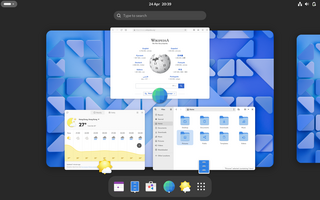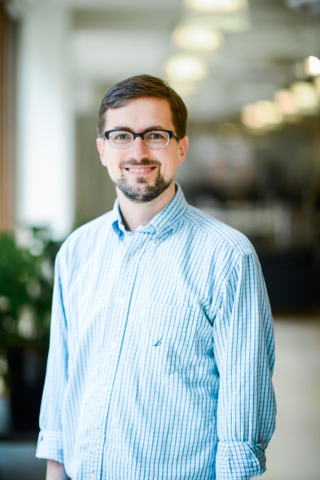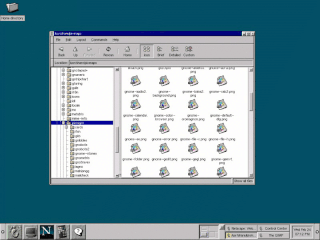
The GNU Image Manipulation Program, commonly known by its acronym GIMP, is a free and open-source raster graphics editor used for image manipulation (retouching) and image editing, free-form drawing, transcoding between different image file formats, and more specialized tasks. It is extensible by means of plugins, and scriptable. It is not designed to be used for drawing, though some artists and creators have used it in this way.
A "Hello, World!" program is generally a simple computer program that emits to the screen a message similar to "Hello, World!". A small piece of code in most general-purpose programming languages, this program is used to illustrate a language's basic syntax. A "Hello, World!" program is often the first written by a student of a new programming language, but such a program can also be used as a sanity check to ensure that the computer software intended to compile or run source code is correctly installed, and that its operator understands how to use it.
An integrated development environment (IDE) is a software application that provides comprehensive facilities for software development. An IDE normally consists of at least a source-code editor, build automation tools, and a debugger. Some IDEs, such as IntelliJ IDEA, Eclipse and Lazarus contain the necessary compiler, interpreter or both; others, such as SharpDevelop and NetBeans, do not.

In software development, GNU Automake is a programming tool to automate parts of the compilation process. It eases usual compilation problems. For example, it points to needed dependencies.

Gambas is the name of an object-oriented dialect of the BASIC programming language, as well as the integrated development environment that accompanies it. Designed to run on Linux and other Unix-like computer operating systems, its name is a recursive acronym for Gambas Almost Means Basic. Gambas is also the word for prawns in the Spanish, French, and Portuguese languages, from which the project's logos are derived.

wxWidgets is a widget toolkit and tools library for creating graphical user interfaces (GUIs) for cross-platform applications. wxWidgets enables a program's GUI code to compile and run on several computer platforms with no significant code changes. A wide choice of compilers and other tools to use with wxWidgets facilitates development of sophisticated applications. wxWidgets supports a comprehensive range of popular operating systems and graphical libraries, both proprietary and free.

Spencer Kimball is an American computer programmer, entrepreneur, and business executive. He is the CEO of Cockroach Labs, a company he co-founded in 2014. His work as a programmer includes creating GNU Image Manipulation Program (GIMP) while still in college, and assisting the source code development of CockroachDB, the namesake software of Cockroach Labs. In addition to Cockroach Labs, Kimball was involved in the founding of other tech startups including WeGo and Viewfinder.

Glade Interface Designer is a graphical user interface builder for GTK, with additional components for GNOME. In its third version, Glade is programming language–independent, and does not produce code for events, but rather an XML file that is then used with an appropriate binding.
Founded in 1986, the eXperimental Computing Facility (XCF) is an undergraduate computing-interest organization at University of California, Berkeley. The "Experimental" description was given in contrast to the Open Computing Facility and the Computer Science Undergraduate Association, which support most of the general-interest computing desires of the campus. As such, the XCF stands as a focus for a small group of computer-scientists uniquely interested in computer science.

GCompris is a software suite comprising educational entertainment software for children aged 2 to 10. GCompris was originally written in C and Python using the GTK+ widget toolkit, but a rewrite in C++ and QML using the Qt widget toolkit has been undertaken since early 2014. GCompris is free and open-source software and the current version is subject to the requirements of the AGPL-3.0-only license. It has been part of the GNU project.

GTK is a free software cross-platform widget toolkit for creating graphical user interfaces (GUIs). It is licensed under the terms of the GNU Lesser General Public License, allowing both free and proprietary software to use it. It is one of the most popular toolkits for the Wayland and X11 windowing systems.

GNOME originally an acronym for GNU Network Object Model Environment, is a free and open-source desktop environment for Linux and other Unix-like operating systems.

Solar2D is a free and open-source, cross-platform software development kit originally developed by Corona Labs Inc. and now maintained by Vlad Shcherban. Released in late 2009, it allows software programmers to build 2D mobile applications for iOS, Android, and Kindle, desktop applications for Windows, Linux and macOS, and connected TV applications for Apple TV, Fire TV and Android TV.

GTK Scene Graph Kit (GSK) is the rendering and scene graph API for GTK introduced with version 3.90. GSK lies between the graphical control elements (widgets) and the rendering.

CockroachDB is a source-available distributed SQL database management system developed by Cockroach Labs. The relational functionality is built on top of a distributed, transactional, consistent key-value store that can survive a variety of different underlying infrastructure failures, and is wire-compatible with PostgreSQL which means users can take advantage of a wide range of drivers and tools from the extensive PostgreSQL ecosystem. A CockroachDB cluster consists of a number of nodes that can be spread across failure domains such as data centres or public cloud regions. A cluster can be scaled both horizontally and vertically. It can provide high levels of resilience and availability and can be run in a variety of environments such as bare metal, VMs, containers and Kubernetes, both in private data centers and in the cloud. CockroachDB gets its name from cockroaches, as they are known for being disaster-resistant.

Ben Darnell is an American computer programmer, entrepreneur, and business executive. He is the chief technology officer for Cockroach Labs, a company he co-founded in 2015. Prior to his work at Cockroach Labs, he worked for tech companies that include FriendFeed, Facebook, Brizzly, Dropbox, Viewfinder, and Square, Inc.

Fractal is an instant messaging client and collaboration software for the GNOME desktop based on the Matrix protocol.

GNOME 1 is the first major release of the GNOME desktop environment. Its primary goal was to provide a consistent user-friendly environment in conjunction with the X Window System. It was also a modern and free and open source software alternative to older desktop environments such as the Common Desktop Environment (CDE), but also to the K Desktop Environment (KDE). Each desktop environment was built-upon then proprietary-licensed widget toolkits, whereas GNOME's goal from the onset, was to be freely-licensed, and utilize the GTK toolkit instead.















